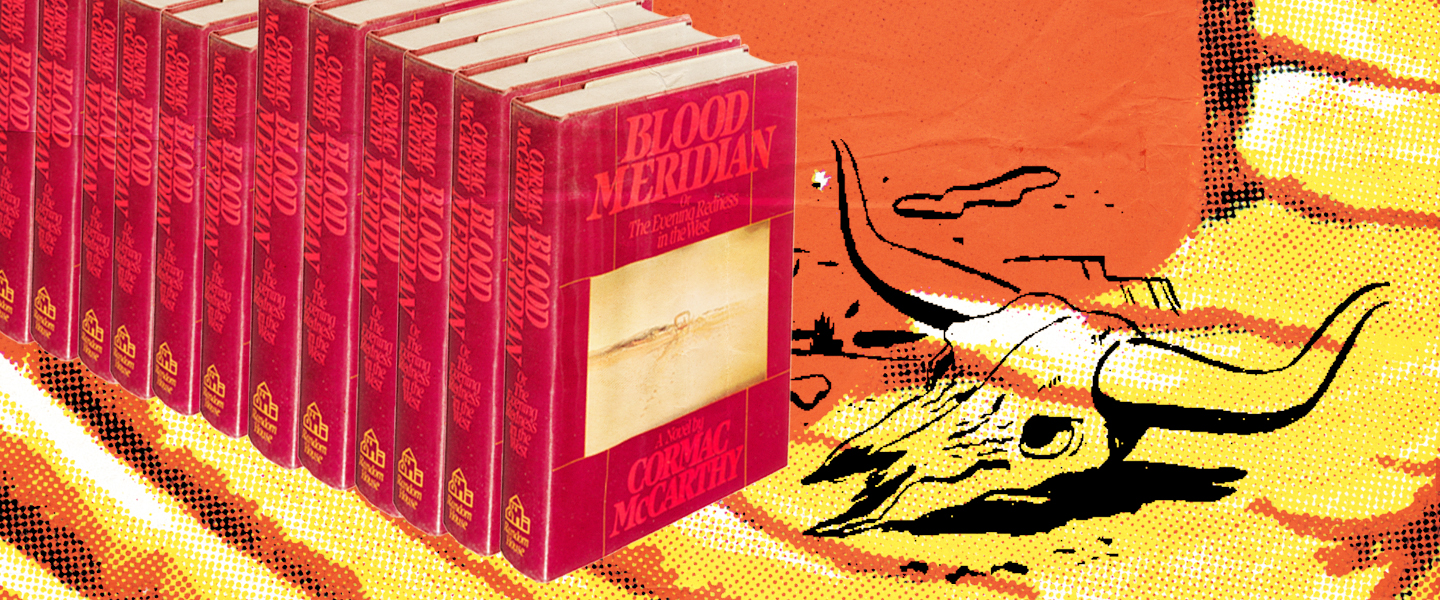 Blood Meridian, Cormac McCarthy’s fifth book, was first published in 1985 to lukewarm critical and commercial reception. It’s gone on, of course, to become recognized as McCarthy’s masterpiece and among the greatest American novels of all-time.
Blood Meridian, Cormac McCarthy’s fifth book, was first published in 1985 to lukewarm critical and commercial reception. It’s gone on, of course, to become recognized as McCarthy’s masterpiece and among the greatest American novels of all-time.
All the while, it’s been the source of one troubled, incomplete or unsuccessful Hollywood adaptation after another. (It’s about a teenager referred to only as “The Kid,” who joins a gang of scalp-hunters in the Southwest and becomes embroiled in a battle of wills with the bald, erudite, imposing Judge Holden.) Steve Tesich (Breaking Away and The World According to Garp) first attempted to translate it to the big screen in 1995, followed in subsequent decades by efforts that stalled at various stages from Tommy Lee Jones; the Kingdom of Heaven pairing of William Monahan and Ridley Scott; James Franco; Andrew Dominik (The Assassination of Jesse James by the Coward Robert Ford); John Hillcoat (The Road); Michael Haneke (The White Ribbon); and Lynne Ramsay (We Need to Talk About Kevin). Meanwhile, producer Scott Rudin has owned the rights to the novel since at least 2004, but thus far hasn’t found the right collaborator — or right take — to move forward with any of them.
Again, McCarthy’s novel is as prestigious a text as a filmmaker is likely to receive: a brutal, unvarnished, amoral portrait of the American West, to be sure, but one also seeded with the author’s extraordinary text, and if not a particularly rousing “hero” (The Kid) then at least a potential all-time great villain (Judge Holden). So what is it that’s keeping Blood Meridian from getting turned into the next No Country for Old Men?
For answers, I turned to a trio of Blood Meridian and/or McCarthy experts: Stacey Peebles, Director of Film Studies at Centre College and editor of The Cormac McCarthy Journal; Noah Gallagher Shannon, writer of Oxford American’s “Old Woods and Deep,” a survey of McCarthy, his fans and followers; and character actor Mark Pellegrino, who played the infamous Judge Holden in a test reel Franco shot for Rudin in 2016.
Their insights speak both to the intense, unflinching specificity of McCarthy’s depiction of a particularly violent time in American history, and to the challenges of translating it to the screen without either neutering the author’s work or producing a film defined by unrelenting, misanthropic cruelty, both physical and philosophical.
But on a deeper level, my conversations brought up something larger and more ineffable: why it is that some novels end up being tagged as “unfilmable,” a moniker that can be both a blessing and a curse. (In some perverse way, Blood Meridian is even more legendary a book simply because so many great filmmakers have tried and failed to bring it to the big screen.) Along those same lines, my subjects also wrestled with how McCarthy’s novel epitomizes the cinematic Western — and the many ways that it doesn’t; if a book can be so great that it simply can’t be adapted; and the parts of Blood Meridian’s particular genius that curses any filmmaker who dares come near it.
Okay, let’s start with the obvious: Is turning Blood Meridian into a movie impossible?
Shannon: If you read these different roundups on IndieWire and other places, the word “unfilmable” gets used over and over again. I don’t know exactly what that means, but I guess the knee-jerk reaction is that there’s just too much unrelenting violence or gore in the book and that scares away producers, studios or directors in terms of figuring out how to do it. But it also strikes me as the kind of challenge that a filmmaker might be interested in — certainly the history of American cinema is full of violent movies.
It keeps being perceived as a cinematic problem — what to do with these visuals of violence — but I see it much more as a writing problem. Because if you strip down the book and look at it, you have a protagonist who only shows up occasionally; I mean, beyond the first couple of chapters, he disappears for the bulk of the book. Then it’s just a group of men riding into different villages either getting drunk or butchering people and moving on to a different village. At times, a tease of a plot will show up — chasing down some Native American leader or vengeance against some particular group. But that will melt away, and the group will ride on to some other place and start committing indiscriminate violence.
So if you’re a writer, you’re going, “How do I make a story out of this?” Because so much of the book’s propulsive energy and its singularity lies in these grand descriptions of the landscape and McCarthy’s different analytical sections, thinking aloud about philosophy, fate, the cosmos and these other larger topics. If that’s moving along the action in the book, how do you do that? It would require someone willing to take some risks to reimagine how to bring the thing on to the screen.
But also, taking those risks on a book that’s a classic and that means a lot to people is probably a level of anxiety people don’t want to take on.
Peebles: I did research on this, and I managed to find at least seven people who have had their name on an adaptation of Blood Meridian. Some sounded more like ideas or maybe a half-finished script, but with others, there was a finished screenplay. Steve Tesich’s script is actually in a library in Texas that you can read. I also found one online by William Monahan, but I could never authenticate it. Then James Franco did a little test reel that he put online; I think he had a full script, too.
McCarthy himself was asked about adapting Blood Meridian in an interview he gave when The Road came out, and he said it’s not impossible. He said something like, “You have to have an imagination and a lot of balls to do it.”
I kind of think the same thing. I mean, it’s hyper-violent and dense — both historically and philosophically. But you know, you pick an angle and run with it. In fact, Steve Tesich’s script has always seemed to me to be an openly philosophical, cosmological interpretation, and it sort of boils down to making Judge Holden pretty explicitly a Satan figure and The Kid a Christ figure. It’s weird, but the script works because it’s making some choices. It’s not trying to be utterly faithful to the book. At a certain point, you gotta do your own thing — no matter how much you love the book.
Shannon: With some of the loftier passages or gruesome violence stripped away, there really is an interesting character study or morality tale at the center of it — The Kid falling in with this gang, and either going along with the violence or not. But then you imagine someone reading McCarthy aloud on the screen, and it seems absurd. Some of his passages are aspiring toward grand biblical syntax and read outside of the context of the book or the page, they risk looking ridiculous or portentous.
Peebles: When Billy Bob Thornton was working on All the Pretty Horses, he tried to account for some of the landscape descriptions by having long shots and creating a pace that matched this landscape and the characters riding through it. It was very beautiful, but it also took a long time. As such, he famously got into this war with Miramax about the length of the movie and had to cut it down, which he was very upset about.
Then you’ve got the Coen Brothers, whose No Country for Old Men isn’t overly long, but it begins with a short montage of shots of the landscape — a turning windmill, an empty horizon and the voice of the sheriff that’s setting up the story for you, which is basically taken straight from the book. It’s overlaid with plot because you’re hearing the sheriff, you’re hearing about his character, and then you see Anton Chigurh. Thus, in a pretty condensed time period, you’ve not only set up two of your really important characters, but you’ve gotten a sense of the landscape too.
So a masterful filmmaker can do it; that’s their language. But it’s not words on a page; it’s going to be something different.
Can the Coen Brothers strategy be applied to Blood Meridian?
Peebles: In academia, there’s a term, “superimposition,” that we use to talk about what happens with a successful film adaptation. It’s when you’re using the source text, but you’re also superimposing your own style as a director or screenwriter. So No Country is a Coen Brothers movie from start to finish, but it’s also very McCarthy. Whereas others, if they’re weaker on one or the other, they maybe don’t work as well.
But the No Country approach would be totally possible with Blood Meridian, because it’s just so compelling, interesting and cinematic. Now, the characters are really enigmatic, and per usual, McCarthy doesn’t give readers a lot of access into their inner monologues or psychology. So we have to infer a lot of that from their actions, particularly The Kid’s. He’s not very interesting, but he’s clearly the one you’re supposed to be paying attention to. That said, you can still make some inferences about who he is, what he wants and how he changes over the course of the novel.
Again, there’s still all the violence. I mean, there’s a scene in the novel where the main character comes across a tree hung with dead babies. You don’t do that in cinema. But you could do other things. A lot of the violence, too, is just historical Old West violence between whites, Native Americans, the Mexican Army and marauders of various kinds, which there’s certainly a precedent for.
Do you think, though, a modern audience will have less tolerance for a traditional recounting of that kind of violence or simply not want to bring itself to relive, or re-contextualize, it?
Pellegrino: I’m sort of with that Preston Sturges thing that people don’t necessarily want realism or nihilistic quote-unquote realism — and the book is so nihilistic. They want to go to be entertained and escape. They want to come out of a movie a little bit happier than when they went into it, or more knowledgeable. And there’s nothing really constructive about a movie where the devil wins in the end.
Peebles: There is, though, stuff like Wind River, which is pretty hard hitting. It’s not set in the literal West, but I read it as a Western. It still has a romantic element as well, like a cowboy hero who’s solving things by the end of the story. The same could be said of Blood Meridian. In it, you’re really watching this young Kid who’s thrust into the middle of this period of manifest destiny and hyperbolic violence. While he participates in it, you see little moments of resistance as the story goes on. And by the end, he may be stepping back and saying, “Even though I have nothing else that’s pushing me toward morality — I have no education, religious affiliation, I’m not bound by law because of where I’m living — I’m moving in that direction anyway.”
Shannon: The book is largely about what happens in vacuums of governance, laws and goodness. The story is essentially about a boy who was raised amongst wolves, and what moral system appears for him as he’s in a pretty literal way tempted by the devil. The character is irredeemable, violent and stoic, but he’s also a vessel for these forces of the frontier, which thrust people into situations where there wasn’t law and order, or systems of established morality. He’s thrust into a group of people representing all these racist, greedy forces, and he both goes along with it and doesn’t. At the end, he’s even destroyed by his unwillingness to go all the way.
That’s maybe an optimistic interpretation, but in terms of masculinity, it’s watching what kind of destruction and chaos these forces can set off if unchecked. That seems pretty nihilistic on the surface, but depiction isn’t always endorsement, right? I wonder if this story is a parable about what these forces of imperialism, racism, unchecked male violence and greed can wrack on a landscape — and really, each other. After all, at the end, there’s only one person remaining. So it does seem like McCarthy is interested in the relationship of these men to the landscape and how they destroy each other in unchecked ways.
Pellegrino: Iconic Westerns are usually thematically oriented around justice and individualism. Even if something ends tragically or if injustice prevails, it’s because you see its opposite as having value. In Blood Meridian, there’s nothing. It’s just so, so vicious, mysterious and ambiguous. It ends on a really bizarre, charged, strange note, and it would leave a bad taste in my mouth with the devil triumphing. Even with the crazy psychopath of No Country for Old Men, there’s a clarity to the character’s intent — you’ve got a mission to accomplish and an integrity that makes the movie palatable. But there’s none of that in Blood Meridian, and unless someone creates a script that has it, the movie will probably never go.
Shannon: There’s also the issue of casting, as the whole movie hinges on being able to get someone who’s a good enough Judge to energize the entire movie in the same way No Country hinged on Javier Bardem being one of the great villains of all-time, which is a hard thing to cast for — like, “All right, we have to cast for a once-in-a-generation villain.”
Peebles: I like the idea of casting somebody who’s not an obvious choice for that reason. Now, you do need somebody who can read as impossibly educated and yet can talk to anybody. He isn’t obviously Satan, but he has the attraction of the darkness without being too cliché about it. People have said, “Wouldn’t it be great if Marlon Brando could have done this around the time he did Apocalypse Now?” Something like that is maybe the closest cinematic corollary to what a lot of people imagine. It’s a fun conversation because over the years people have aged into or out of the realm of possibility.
Pellegrino: I’ve known James Franco since he was 17 or 18. He went to a theater company that I was a part of, so I’m assuming that’s why I worked on the project. I also played the devil on a CW show, and the Judge is the devil in many respects. So maybe I got typecast (laughs). Then it was four or five grueling days of shooting bits and pieces of the novel up in a little town near Memphis.
I honestly didn’t feel like I had the physical or cultural capacity to fill that character, because for me, Brando could fill the Judge’s shoes and there are a couple of actors who have the requisite unpredictability and combination of culture and facility for language that the Judge might have. But there’s like three of them, maybe, and that’s even a stretch. He’s an extremely difficult character to fill out and make right. Given the time limits, I read the book and drew my conclusions, but I don’t know how much of that came across. I haven’t even really seen it.
So given the topic at hand, I can’t help but end where I started: Is turning Blood Meridian into a movie impossible?
Peebles: I honestly believe that with the right spin, it’s got potentially huge appeal — because of McCarthy. You have one of the greatest living American authors. He’s won a Pulitzer, and this is arguably his master work. It also has this history of failed adaptations, which lends another cachet, like it’s so amazing that it’s never been brought to the screen! Plus, today’s political context doesn’t have to be a burden either. It can be an advantage.
See? It’s not that hard to pitch.

